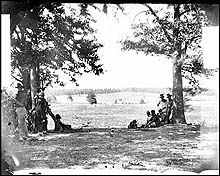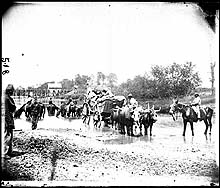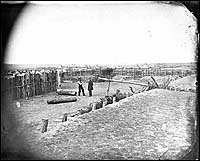Today in History: August 30
The Second Battle of Manassas

Battlefield,
Cedar Mountain, Virginia,
Timothy H O'Sullivan, photographer,
August 1862.
Selected Civil War Photographs, 1861-1865
On August 30, 1862, the Second Battle of Manassas ended a long campaign in northern Virginia. The campaign had begun when Union forces attempting to invade the Southern capital at Richmond were defeated just miles from the city. After the defeat near Richmond, the scattered Union forces under Major General John Pope clashed repeatedly with the Southern troops under Major General "Stonewall" Jackson. At the August 9 Battle of Cedar Mountain, Jackson's Confederates outnumbered the Union troops two-to-one. After his easy victory there, Jackson retired from the field as Union reinforcements arrived.
While Pope's Union army was engaged in fighting against General Robert E. Lee's forces along the Rappahannock River, Jackson attempted to maneuver around to Pope's rear in order to cut off his supply lines.
Weary from inconclusive fighting along the Rappahannock, Pope decided to concentrate his forces and march on Jackson, who had succeeded in cutting off Pope's supplies. A race was on for Pope to find and destroy Jackson before Lee could march his men to Jackson's aid.

Fugitives Fording the Rappahannock,
Timothy H O'Sullivan, photographer,
August 1862.
Selected Civil War Photographs, 1861-1865
During the Union occupation of Northern Virginia, many slaves took the opportunity to escape. This 1862 photograph, taken by Timothy O'Sullivan, shows a group of fugitive slaves fording the Rappahannock River on their way North.
The Second Battle of Manassas began on August 28, when Pope marched his men right into Jackson's waiting forces near the town of Manassas. Jackson had set up his defenses at the site of the First Battle of Manassas which had ended in Confederate victory just one year earlier. After some rough skirmishes, darkness fell, and both sides retired for the night.

The Principal Fort,
Centreville, Virginia,
George N. Barnard, photographer,
March 1862.
Selected Civil War Photographs, 1861-1865
Throughout the day of August 29, fighting raged up and down the line without a decisive victory. Pope's Northerners broke through the Confederate defenses several times but were always pushed back. Throughout that night, Confederate movement to the west convinced Pope that the Southerners were preparing to retreat.
On the morning of August 30, Pope attacked the Confederates to the west, hoping to destroy the escaping Southern troops. Instead, he found 30,000 newly-arrived reinforcements under General Robert E. Lee. The day was spent in fierce fighting; in the end, the Northerners were forced to retreat to nearby Centreville and, eventually, to the safety of Washington, D.C.
28th started for Manassas, arriving there 29th. 30th and 31st were engaged in the battle—the troops behaving with great coolness, courage and in perfect order—about 11 oclock at night left the battle field, (being the last regiment that left and having the credit of saving the artillery.) and bivouak'd that night at Centreville. Left the latter place Sept. 1st at 5 a.m. arriving at Chantilly at dusk—here occuring a sharp engagement (Battle of Chantilly) lasting till 10 oclock at night. (It rained furiously, and the conflict was in the woods.)Walt Whitman, Notebook #94, page 127.
Walt Whitman Notebooks, 1847-1860s
The Library of Congress holds over forty of Walt Whitman's notebooks. Whitman used the notebooks to record his thoughts and observations in prose and in poetry. During the Civil War, Whitman carried small notebooks with him on visits to wounded soldiers in hospitals. He jotted down stories that the soldiers told and took note of treats or supplies which he could bring to the men on return visits.
- Band Music from the Civil War Era makes available examples of brass band music played by the armies of both the North and the South during the Civil War. Read about The Civil War Bands in the context of The American Brass Band Movement. Also, search on the terms regiment or battle to find tunes such as the "15th Regiment Quick March."
- Search on Cedar Mountain, fugitive, Centreville or names of battles in the collection Selected Civil War Photographs, 1861-1865. See, for example, the Centreville, Virginia, Confederate Winter Quarters.
- Search the Today in History Archive on Civil War to read about battles such as the Battle of Antietam, the Battle of Gettysburg, and the Battle of Bull Run, the first Civil War battle fought in the vicinity of Manassas, Virginia.
- Sift through Walt Whitman Notebooks, 1847-1860s to read from the poet's musings on the battles and casualties of the Civil War. Read pages 108-113 and 127-131 in notebook #94 for observations and stories of the campaign in northern Virginia.